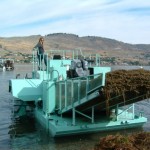The Okanagan Basin Water Board (OBWB), the organization responsible for control of the invasive aquatic plant Eurasian watermilfoil, will be commencing harvesting operations at the south end of Wood Lake, in front of Beasley Park, from Monday, July 27 to Friday, July 31.
The OBWB typically controls watermilfoil at the south end of Wood Lake during the winter using de-rooting machines. Summer harvesting has not occurred in this area since 2004. According to Ian Horner, Crew Supervisor for the OBWB, “the substantial and long-lasting ice cover on Wood Lake this year prohibited winter de-rooting from taking place and resulted in the need for summer harvesting.”
The harvester operated by the OBWB will cut the weeds about two metres under the water surface in order to maintain beach recreation, boat navigation and aesthetics. Once the weeds are cut, much like a lawnmower cuts grass, the cuttings are deposited on shore to be trucked away. The OBWB is asking residents to be aware of the harvester, to stay out of its path while it is operating, and to understand that the machine and any weed piles will only be in the vicinity of Beasley Park until July 31.
Any questions about the watermilfoil program can be directed to Genevieve Dunbar at the OBWB, by phone: 250-469-6270 or email: genevieve.dunbar@obwb.ca. The District of Lake Country Parks Department has partnered with the OBWB for this project, allowing access to Beasley Park. More information about Beasley Park is available by calling Steve Schaffrick at the District of Lake Country at 250-766-5650.
The goals of the OBWB’s Eurasian Watermilfoil Control Program are to minimize environmental impacts while enhancing public enjoyment of Okanagan mainstem lakes in a cost effective and efficient program that benefits the regional economy. Eurasian watermilfoil will not be eradicated through this program but weed density is reduced so that growth does not interfere with public enjoyment of our lakes, or have negative impacts on the aquatic ecosystem.

